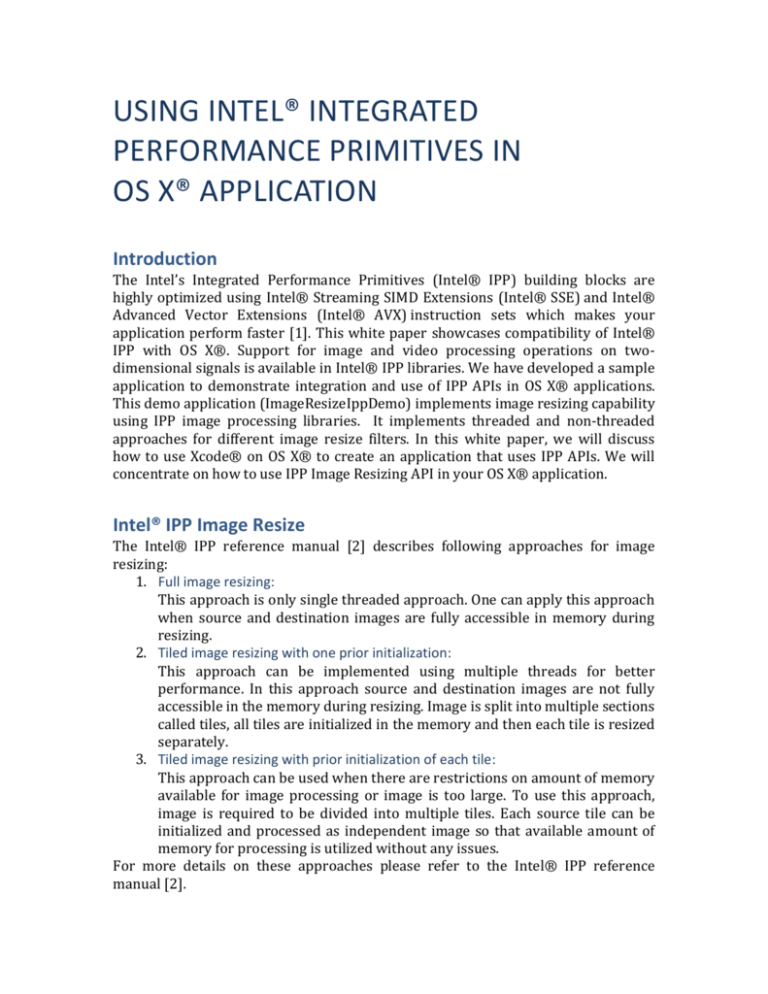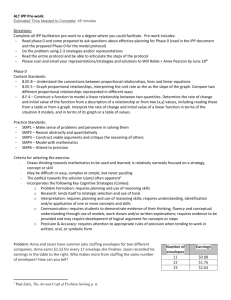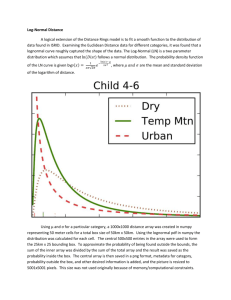
USING INTEL® INTEGRATED
PERFORMANCE PRIMITIVES IN
OS X® APPLICATION
Introduction
The Intel’s Integrated Performance Primitives (Intel® IPP) building blocks are
highly optimized using Intel® Streaming SIMD Extensions (Intel® SSE) and Intel®
Advanced Vector Extensions (Intel® AVX) instruction sets which makes your
application perform faster [1]. This white paper showcases compatibility of Intel®
IPP with OS X®. Support for image and video processing operations on twodimensional signals is available in Intel® IPP libraries. We have developed a sample
application to demonstrate integration and use of IPP APIs in OS X® applications.
This demo application (ImageResizeIppDemo) implements image resizing capability
using IPP image processing libraries. It implements threaded and non-threaded
approaches for different image resize filters. In this white paper, we will discuss
how to use Xcode® on OS X® to create an application that uses IPP APIs. We will
concentrate on how to use IPP Image Resizing API in your OS X® application.
Intel® IPP Image Resize
The Intel® IPP reference manual [2] describes following approaches for image
resizing:
1. Full image resizing:
This approach is only single threaded approach. One can apply this approach
when source and destination images are fully accessible in memory during
resizing.
2. Tiled image resizing with one prior initialization:
This approach can be implemented using multiple threads for better
performance. In this approach source and destination images are not fully
accessible in the memory during resizing. Image is split into multiple sections
called tiles, all tiles are initialized in the memory and then each tile is resized
separately.
3. Tiled image resizing with prior initialization of each tile:
This approach can be used when there are restrictions on amount of memory
available for image processing or image is too large. To use this approach,
image is required to be divided into multiple tiles. Each source tile can be
initialized and processed as independent image so that available amount of
memory for processing is utilized without any issues.
For more details on these approaches please refer to the Intel® IPP reference
manual [2].
The ImageResizeIppDemo application implements the first two resizing approaches.
Older versions of IPP did not support interpolation filters for image resizing. They
supported Square Pixel resizing technique. In IPP 7.1, Square pixel resizing
functions are deprecated and the developer is provided with new implementations
of following interpolation filters [2]:
1. Nearest Neighbor Resize: In this resizing technique, each pixel in the
destination image is filled by copying the value of one pixel at the nearest
corresponding location in the source image.
2. Linear Resize: In this resizing technique, the values for destination image
pixels are determined by weighing 4 surrounding pixels of corresponding
pixel in the source image.
3. Cubic Resize: In this resizing technique, the value for destination image pixels
are determined by weighing 16 surrounding pixels of corresponding pixel in
the source image.
4. Lanczos Resize: In this resizing technique, samples are weighted via a
windowed sine function.
5. Super-sampling: This resizing technique has a limitation that, it can be used
only for down sampling or downscaling of images.
In the above list, as we go from top to bottom, quality of resized image increases but
image-resizing speed decreases.
The quality of the resized image can be improved further with anti-aliasing support
for above resize filters. IPP 7.1 doesn’t support anti-aliasing for these new
interpolation filters.
IPP provides resize functions for each interpolation filter type:
ippiResizeNearest_<mod>
ippiResizeLinear_<mod>
ippiResizeCubic_<mod>
ippiResizeLanczos_<mod>
ippiResizeSuper_<mod>
Here, the value for <mod> depends upon the source image format (i.e. pixels per
component, number of channels, etc.).
Before calling any of the above resize functions, we need to make sure everything
required for resize functions is setup. Following is the required setup [2]:
1. Call the ‘ippiResizeGetSize’ function with the appropriate interpolation type.
This function uses source and destination image sizes to calculate how much
memory must be allocated for the ‘IppResizeSpec’ structure and
initialization work buffer.
2. Initialize the ‘IppResizeSpec’ structure by calling the ‘ippiResize<Filter>Init’,
where <Filter> can take one of the following values: Nearest, Linear, Cubic,
Lanczos, and Super. These prerequisite steps allow resize to be called
multiple times without recalculations.
IPP also provides very handy memory management and copy functions:
1. ippiMalloc_<mod>: Allocates memory aligned to 32-byte boundary.
2. ippiFree: Frees memory allocated by the function iipiMalloc.
3. ippiCopy_<mod>: Copies pixel values between two buffers. Different modes
of ippiCopy function also provide ability to divide images into separate
planes/channels OR combine separate image planes/channels into a single
image.
These memory management functions can be used to prepare input and output
memory buffers, working buffer required by resize functions, etc.
For more details about different IPP Image Processing functions please refer to IPP
Image Processing user guide.
Integrating IPP with Xcode®
Install and setup Intel® IPP latest version that comes with the Intel C++ and Fortran
compilers distribution packages. Please refer to the IPP Home page to find installers
and the installation guide [1]. Generally, on OS X®, IPP gets installed inside
‘/opt/intel/composer_xe_<version>/ipp’. The folder ‘/opt/intel/ipp’ is a symbolic
link to the ‘/opt/intel/composer_xe_<latest_version>/ipp’.
To develop your own OS X® application, you will need to download and install the
latest version of Xcode® on your system. Once you have Xcode ready for
development, create a new project and link IPP libraries to your project.
Following are the steps to setup a new IPP project in Xcode 4.x:
1. To create a new Xcode project, select File -> New -> Project menu item.
2. Choose ‘Cocoa Application’ from the provided options and hit ‘Next’ button.
3. Choose options for your new project on the next page and hit ‘Next’ button.
4. Choose a location to save your new project and hit ‘Create’ button. This will
create and open your new project in Xcode.
5. Now add required functionality to your project.
6. Import <ipp.h> header file in all the classes, which call IPP functions or use
IPP data-types.
7. To build and run your application successfully, link against IPP libraries.
Following are the instructions to link IPP libraries statically or dynamically to your
Xcode project:
Static linking of IPP libraries
1. In Xcode project, under the project root, create a group named ‘libs’.
(Optional)
2. Select ‘libs’ group and open the context menu. Select ‘Add file to
<project_name>’ context menu item. It will open a sheet with add file
panel. Browse to the location where IPP is installed, then select required
static libraries and click on ‘Add’ button. Screenshot 1 shows the Xcode 4
project in which static IPP libraries are added.
3. Now go to your project’s build settings. Search for ‘Library Search Paths’
and add a non-recursive search path for ipp/libs to it.
(e.g. ‘/opt/intel/ipp/lib’ )
4. In project build settings, search for ‘Header Search Paths’ and add
recursive search path to ipp/include to it.
(e.g. ‘/opt/intel/ipp/include’)
5. Your IPP project should now statically link against IPP libraries without
any issues.
Screenshot 1
Dynamic linking of IPP libraries
1. If you are using Xcode 4, then go to your project’s ‘Build Phases’.
2. Expand ‘Link Binary With Libraries’ section. Click on ‘+’ to add IPP dylib
files. Following screenshot-2 shows IPP dynamic libraries added to the
Demo Application.
Screenshot 2
3. Now go to your project’s build settings. Search for ‘Library Search Paths’
and add a non-recursive search path for ipp/libs to it.
(e.g. ‘/opt/intel/ipp/lib’ )
4. In project build settings, search for ‘Header Search Paths’ and add
recursive search path to ipp/include to it.
(e.g. ‘/opt/intel/ipp/include’)
5. Last step is to select Xcode’s ‘Product -> Edit Scheme’ menu. Add a new
Environment
Variable
‘DYLD_LIBRARY_PATH’
with
value
‘/opt/intel/ipp/lib:/opt/intel/lib’ as shown in the following screenshot3. Note that even if you set this environment variable from terminal, you
will still need to set it again in Xcode.
Screenshot 3
If you are using an older version of Xcode then please refer to the Link IPP Libraries to
your OS X® project page.
Using IPP API with Objective-c
IPP function can be called directly from your cocoa objective-c classes. To use IPP
functions or data types, objective-c classes are required to include header <ipp.h>.
To understand this with example, please download and refer to the
ImageResizeIppDemo application.
ImageResizeIppDemo application dynamically links IPP libraries to the project.
Before running this application from Xcode, make sure that in your project schema,
the environment variable ‘DYLD_LIBRARY_PATH’ is set to the value
‘/opt/intel/ipp/lib:/opt/intel/lib’.
To run this application by double clicking on the built product
(<build_dir>/Products/Release/ImageResizeIPPDemo.app), user will need to take
following steps:
1. Put “setenv DYLD_LIBRARY_PATH /opt/intel/ipp/lib:/opt/intel/lib” in file
/etc/launchd.conf
2. Open terminal and type following command and hit enter
“launchctl setenv DYLD_LIBRARY_PATH /opt/intel/ipp/lib:/opt/intel/lib”
Please refer to the remaining sections of this paper to get more details about the
ImageResizeIppDemo application features, implementation and usage.
Features of IPP Demo Application
The IPP Resize demo application for OS X® has the following features:
This application is developed using Xcode 4 in Objective-c.
Application accepts Image to be resized, scaling factor and interpolation filter
from user. Using scaling factor and interpolation filter, it resizes the source
image using IPP image resize capability and renders the output to the screen.
For each interpolation filter it has two different implementations, threaded
and non-threaded. It uses Apple’s Grand Central Dispatch (GCD) technique
for threaded implementation.
Application allows user to resize original image multiple times without
requiring reloading the image.
Application also allows user to save the image in any image format.
Implementation Details of ImageResizeIppDemo Application
The ImageResizeIppDemo application reads input image in the CGImage format, but
IPP resize functions work on image byte data. Hence, we need logic for conversion
from CGImage to image byte data and from Image byte data to CGImage.
Here is how this application implements image format conversions using Apple’s
Core Graphics API [4][5]:
CGImage to Image byte data buffer
- (const void *)getGCImageData
{
CFDataRef imageData =
CGDataProviderCopyData(CGImageGetDataProvider(inputImage));
NSData *theNSData = (__bridge NSData*)imageData;
const void* ImageBytes = [theNSData bytes];
CFRelease(imageData);
return ImageBytes;
}
Image byte data buffer to CGImage
- (void)createGCImageFromPixelData:(const void *)img
stride:(int)stride
width:(int)width
height:(int)height
{
size_t size = stride * height;
CGDataProviderRef dataProvider =
CGDataProviderCreateWithData(NULL, img, size, NULL);
CGImageRef inputImage = CGImageCreate( width, height,
self.bitsPerComponent,
self.bitsPerPixel, stride, self.colorSpaceRef,
self.bitmapInfo, dataProvider,
self.decodeArray, self.shouldInterpolate,
self.renderingIntent);
CGDataProviderRelease(dataProvider);
}
This demo application has a class IPPImageScaler, which provides interface for
implementation of IPP image resizing with different IPP filters. As IPP imageprocessing libraries have different versions of API functions depending on image
formats (i.e. depending on bits per component value and number of channels in the
image.), IPPImageScaler has been further sub-classed into three different classes;
IPP8uImageScaler, IPP16uImageScaler, IPP32fImageScaler which override IPP
image resize implementations provided by IPPImageScaler.
The IPP API provides memory allocation functions that allocate aligned memory for
data of required type. There are different versions of IPP memory allocation
functions as well depending on image formats. This demo application implements a
function, which prepares memory buffers for source and output images and keeps it
ready to be used in IPP resize functions.
Following is an implementation of ‘preparation’ function for 8 bit image formats.
- (void)preparation
{
dstsize.width = mImage.srcImageSize.width * self.scalingFactor;
dstsize.height = mImage.srcImageSize.height * self.scalingFactor;
if( mImage.numChannel == 1 )
{
// -------------------------// get the image size
// -------------------------pSrc = ippiMalloc_8u_C1(mImage.srcImageSize.width,
mImage.srcImageSize.height, &stridesrc);
pDst = ippiMalloc_8u_C1(dstsize.width, dstsize.height, &stridedst);
// --------------------------// read the source image
// --------------------------ippiCopy_8u_C1R(srcImage, mImage.srcImageSize.width *
mImage.bitsPerPixel/8, pSrc, stridesrc, mImage.srcImageSize);
}
else if( mImage.numChannel == 3 )
{
pSrc = ippiMalloc_8u_C3(mImage.srcImageSize.width,
mImage.srcImageSize.height, &stridesrc);
pDst = ippiMalloc_8u_C3(dstsize.width, dstsize.height, &stridedst);
ippiCopy_8u_C3R(srcImage, mImage.srcImageSize.width *
mImage.bitsPerPixel/8, pSrc, stridesrc, mImage.srcImageSize);
}
else if ( mImage.numChannel == 4 )
{
pSrc = ippiMalloc_8u_C4(mImage.srcImageSize.width,
mImage.srcImageSize.height, &stridesrc);
pDst = ippiMalloc_8u_C4(dstsize.width, dstsize.height, &stridedst);
ippiCopy_8u_C4R(srcImage, mImage.srcImageSize.width *
mImage.bitsPerPixel/8, pSrc, stridesrc, mImage.srcImageSize);
}
else
{
NSLog(@"Unsupported color component format");
}
}
Note: In this function ‘srcImage’ is nothing but input image
byte data returned by conversion function - (const void
*)getGCImageData mentioned above.
This application implements resize functions with two different approaches. The
non-threaded approach, which performs full image resizing using IPP API and the
threaded approach, which performs tiled image resize using IPP API.
Lets see how these approaches are implemented in Objective-c. Here, we will show
the implementation of resizing with linear interpolation filter.
Following is the function declaration in the interface for linear resize:
- (const void *)linearResizeWithIsthreadedFlag:(BOOL)isThreaded
stride:(NSInteger *)outputStride;
Function parameters:
1. (BOOL)isThreaded Flag
This function accepts a flag to decide whether to execute threaded
implementation or non-threaded implementation, or in other words,
whether to perform full image resize or tiled image resize.
2. (NSInteger *)outputStride
Another parameter is Stride, which is an output parameter. Value for the
stride is calculated for the output image with new size and it is then used
while creating GCImage from output image byte data.
Return Value:
The function returns resized image byte data in the form of (const void *). With
the above conversion function a CGImage is created from this byte data and
rendered to the screen.
Following is the implementation of linearResizeWithIsthreadedFlag function:
- (const void *)linearResizeWithIsthreadedFlag:(BOOL)isThreaded
stride:(NSInteger *)outputStride
{
Ipp32s specSize=0, initSize=0, bufSize=0;
IppiResizeSpec_32f *pSpec = 0;
Ipp8u *pInitBuf=0;
//set up spec and working buffers
ippiResizeGetSize_8u( mImage.srcImageSize, dstsize, ippLinear, 0,
&specSize, &initSize );
pInitBuf = ippsMalloc_8u( initSize );
pSpec = (IppiResizeSpec_32f*)ippsMalloc_8u( specSize );
/* Filter initialization */
ippiResizeLinearInit_8u( mImage.srcImageSize, dstsize, pSpec );
IppiPoint dstOffset = {0, 0};
if(!isThreaded)
{
/* work buffer size */
ippiResizeGetBufferSize_8u( pSpec,dstsize,mImage.numChannel,&bufSize );
Ipp8u *pOneBuf=ippsMalloc_8u(bufSize);
if( mImage.numChannel == 1 )
{
ippiResizeLinear_8u_C1R(pSrc,stridesrc,pDst,stridedst,dstOffset,
dstsize, ippBorderRepl, 0, pSpec, pOneBuf);
}
else if( mImage.numChannel == 3 )
{
ippiResizeLinear_8u_C3R(pSrc,stridesrc,pDst,stridedst,dstOffset,
dstsize, ippBorderRepl, 0, pSpec,pOneBuf);
}
else if ( mImage.numChannel == 4 )
{
ippiResizeLinear_8u_C4R(pSrc,stridesrc,pDst,stridedst,dstOffset,
dstsize, ippBorderRepl, 0, pSpec,pOneBuf);
}
else
{
NSLog(@"Unsupported color component format");
ippsFree( pOneBuf);
ippsFree( pSpec );
return nil;
}
ippsFree( pOneBuf);
}
else
{
unsigned int numOfChunks = self.availableCpus, slice, tail;
IppiSize dstTileSize, dstLastTileSize;
Ipp32s bufSize1=0, bufSize2=0;
IppiBorderSize borderSize = {0, 0, 0, 0};
IppiBorderType border = ippBorderRepl;
Ipp8u* pBuffer = 0;
ippiResizeGetBorderSize_8u(pSpec, &borderSize);
slice = dstsize.height / numOfChunks;
tail = dstsize.height % numOfChunks;
dstTileSize.width = dstLastTileSize.width = dstsize.width;
dstTileSize.height = slice;
dstLastTileSize.height = slice + tail;
ippiResizeGetBufferSize_8u(pSpec, dstTileSize, mImage.numChannel,
&bufSize1);
ippiResizeGetBufferSize_8u(pSpec, dstLastTileSize, mImage.numChannel,
&bufSize2);
pBuffer = ippsMalloc_8u(bufSize1 * (numOfChunks - 1) + bufSize2);
dispatch_queue_t queue =
dispatch_get_global_queue( DISPATCH_QUEUE_PRIORITY_DEFAULT, 0 );
if (pBuffer)
{
dispatch_apply( numOfChunks, queue, ^(size_t count) {
Ipp8u *pSrcT, *pDstT;
IppiPoint srcOffset = {0, 0};
IppiPoint dstOffset = {0, 0};
IppiSize srcSizeT = mImage.srcImageSize;
IppiSize dstSizeT = dstTileSize;
dstSizeT.height = slice; dstOffset.y += count * slice;
if (count == numOfChunks - 1)
dstSizeT = dstLastTileSize;
ippiResizeGetSrcRoi_8u(pSpec, dstOffset, dstSizeT, &srcOffset,
&srcSizeT);
pSrcT = (Ipp8u*)((char*)pSrc + srcOffset.y * stridesrc);
pDstT = (Ipp8u*)((char*)pDst + dstOffset.y * stridedst);
if( mImage.numChannel == 1 )
{
ippiResizeLinear_8u_C1R(pSrcT,stridesrc,pDstT,stridedst,
dstOffset, dstSizeT,border, 0, pSpec,
pBuffer + count * bufSize1);
}
else if( mImage.numChannel == 3 )
{
ippiResizeLinear_8u_C3R(pSrcT,stridesrc,pDstT,stridedst,
dstOffset, dstSizeT,border, 0, pSpec,
pBuffer + count * bufSize1);
}
else if ( mImage.numChannel == 4 )
{
ippiResizeLinear_8u_C4R(pSrcT,stridesrc,pDstT,stridedst,
dstOffset, dstSizeT,border, 0, pSpec,
pBuffer + count * bufSize1);
}
});
}
ippsFree( pBuffer );
}
ippsFree( pInitBuf );
ippsFree( pSpec );
*outputStride = (NSInteger)stridedst;
return pDst;
}
Note: All the functions used above that start with ‘ipp’ and the
data types that start with ‘IPP’ are from IPP API. Please refer
to the IPP User Guide for more details about different IPP
image processing functions and data types used in the above
implementation.
Apple’s Grand Central Dispatch (GCD)
Use of Apple’s GCD [6] provides support for concurrent code execution on multicore
hardware systems with OS X®. Please refer to the above implementation of
linearResizeWithIsthreadedFlag method. For the threaded (tiled image resize approach)
implementation, we are using GCD API. We are horizontally dividing image data into
number of chunks. Total number of chunks is same as number of currently available
CPUs on the system, so that each CPU can resize a chunk in parallel reducing the
time required for resizing complete image.
To en-queue image chunks for parallel processing, GCD needs a dispatch_queue.
Application uses one of the global dispatch queues with default priority. To get
global dispatch queue we are using GCD API function dispatch_get_global_queue.
Function takes three parameters as shown in the above
implementation.
1. dispatch_queue
2. A block of code to be executed in parallel
3. Number of times the provided block of code is to be executed. This is same as
number of image data chunks, as, the block of code should be executed for
each image data chunk.
dispatch_apply
User Interface Details of ImageResizeIppDemo Application
When a user runs the application, following window is shown to the user.
Screenshot 4
The user can drag and drop an image to be resized on the ImageView shown above.
This image is represented in the application using Apple’s Core Graphics API.
An NSSlider is provided to accept a scaling factor value. The scaling factor value
selected by the slider is shown in the Text Field displayed above the slider.
The NSPopUpButton in the user interface allows the user to choose an interpolation
filter from available options.
The ‘Save Image’ button allows user to save an image displayed in the imageView
with its current dimensions.
The ‘Quit’ button allows user to close the application window and quit the
application. The user cannot use red close button on top left corner of the window to
close application window or quit the application.
As you see in Screenshot-4, initially, all controls on the window are disabled when
no image is selected for resizing. As soon as the user drops image on the ImageView,
all controls are enabled.
Screenshot 5
Screenshot-5 shows the window with an image loaded in the ImageView and all
controls enabled.
Screenshot 6
Screenshot-6 shows how a user can select interpolation filter and available
interpolation filter options. Whenever the user changes interpolation filter, the
resize functionality gets triggered and the image is scaled with the pre-selected
scaling factor and the new resize filter.
Screenshot 7
Screenshot 7 shows the resized (down-sampled) image to the selected scaling factor
with selected resize filter. The resize functionality gets triggered when user changes
the scaling factor value. The user can also manually edit the scaling factor value in
the TextField and slider adjusts its position to the new value, which again triggers
image resize.
Screenshot 8
Screenshot 8 shows how a user can save the resized image. The save panel is opened
with pre-populated image file name when user clicks on the ‘Save Image’ button.
The user can change the image extension to choose to save image with different
image types.
Image Formats supported in ImageResizeIppDemo Application
This demo application supports the following Image formats:
Gray scale 8 bit/16 bit/ 32 bit
Gray scale with alpha channel
Indexed
Indexed with alpha channel
RGB 8 bit/16 bit/ 32 bit
RGB with alpha channel
CMYK 8 bit/16 bit/ 32 bit
IPP does not have direct support to handle resizing of 2 channel (e.g. 8 bit Gray scale
+ Alpha channel) or 5 channel (e.g. CMYK + Alpha channel) images. You can still
support these image formats using the following techniques:
2 Channel Images
There are two approaches to handle this case. In some cases just using 16 bit
IPP functions to resize this type of images works. This approach works well
with Nearest-Neighbor interpolation filter. Unfortunately, this is not a great
solution, as you can get some strange looking results for some other
interpolation filters.
Another approach is to split the image into 2 planes; 1 for Gray and 1 for
Alpha channel. Then you can safely run two resizes on each image plane
(buffer) separately.
ImageResizeIppDemo application currently implements the first approach to
handle 2 channel images. If resizing 8-bit Gray scale with Alpha channel, then
it treats that image as 16 bit image while resizing.
5 Channel Images
In case of 5 channel images, you can split image in separate planes. For
example, you can split the image into 5 one-channel images OR 1 fourchannel image and 1 one-channel image. Then you can safely run resizes on
separate image buffers and combine resized image buffers back to one when
done. ImageResizeIppDemo application doesn’t support scaling of 5 channel
images currently.
IPP provides some ippiCopy functions that help in separating images into multiple
planes and also combining separate planes into one image.
Workloads used for testing of ImageResizeIppDemo Application
The following table shows the image types and image formats for which this
ImageResizeIppDemo application is tested:
Note:
= Image format available in test data and Application resizes this image
correctly.
− = Test image not available.
TIFF PSD PNG GIF JPG
Gray Scale
8-bit
No Alpha
−
−
8-bit
kCGImageAlphaLast
−
−
−
8-bit
kCGImageAlphaNoneSkipLast
−
−
−
−
−
8-bit
kCGImageAlphaPremultipliedLast −
−
−
−
−
16-bit
No Alpha
−
−
−
Indexed
8-bit
No Alpha
−
−
8-bit
BMP
kCGImageAlphaLast
8-bit
No Alpha
8-bit
kCGImageAlphaLast
8-bit
kCGImageAlphaNoneSkipLast
8-bit
kCGImageAlphaPremultipliedLast
16-bit
No Alpha
8-bit
No Alpha
16-bit
No Alpha
−
−
RGB
−
−
−
−
−
−
−
−
−
−
CMYK
−
−
−
−
−
−
−
Table 1
Summary
Because of the highly optimized implementation of Intel® IPP libraries, the
applications using IPP APIs perform faster. Intel® IPP can be integrated in
development tools on OS X® to use different IPP APIs in cocoa applications.
References
1.
2.
3.
4.
5.
6.
Intel® IPP Home Page: http://software.intel.com/en-us/intel-ipp
Intel® IPP Reference manual: http://software.intel.com/en-us/articles/intelintegrated-performance-primitives-documentation/
Link IPP Libraries to your OS X® project: http://software.intel.com/enus/articles/intel-integrated-performance-primitives-for-mac-os-how-tolink-to-the-intel-ipp-for-mac-os-x-libraries-in-application
Quartz 2D Programming Guide:
https://developer.apple.com/library/mac/#documentation/GraphicsImagin
g/Conceptual/drawingwithquartz2d/Introduction/Introduction.html
Core Graphics Reference Collection:
https://developer.apple.com/library/mac/#documentation/GraphicsImagin
g/Reference/CoreGraphicsReferenceCollection/_index.html
Grand Central Dispatch (GCD):
https://developer.apple.com/library/mac/#documentation/Performance/R
eference/GCD_libdispatch_Ref/Reference/reference.html
About the Author
Sneha Gohad is an Application Engineer in Intel’s Developer’s Relations Division
within the Software and Services Group at Intel, Santa Clara. Sneha has completed
her MS in Computing Studies from Arizona State University with specialization in
application development.
Notices
INFORMATION IN THIS DOCUMENT IS PROVIDED IN CONNECTION
WITH INTEL PRODUCTS. NO LICENSE, EXPRESS OR IMPLIED, BY
ESTOPPEL OR OTHERWISE, TO ANY INTELLECTUAL PROPERTY
RIGHTS IS GRANTED BY THIS DOCUMENT. EXCEPT AS PROVIDED
IN INTEL'S TERMS AND CONDITIONS OF SALE FOR SUCH
PRODUCTS, INTEL ASSUMES NO LIABILITY WHATSOEVER AND
INTEL DISCLAIMS ANY EXPRESS OR IMPLIED WARRANTY,
RELATING TO SALE AND/OR USE OF INTEL PRODUCTS INCLUDING
LIABILITY OR WARRANTIES RELATING TO FITNESS FOR A
PARTICULAR PURPOSE, MERCHANTABILITY, OR INFRINGEMENT OF
ANY PATENT, COPYRIGHT OR OTHER INTELLECTUAL PROPERTY
RIGHT.
UNLESS OTHERWISE AGREED IN WRITING BY INTEL, THE INTEL
PRODUCTS ARE NOT DESIGNED NOR INTENDED FOR ANY
APPLICATION IN WHICH THE FAILURE OF THE INTEL PRODUCT
COULD CREATE A SITUATION WHERE PERSONAL INJURY OR
DEATH MAY OCCUR.
Intel may make changes to specifications and product descriptions at any
time, without notice. Designers must not rely on the absence or
characteristics of any features or instructions marked "reserved" or
"undefined." Intel reserves these for future definition and shall have no
responsibility whatsoever for conflicts or incompatibilities arising from
future changes to them. The information here is subject to change without
notice. Do not finalize a design with this information.
The products described in this document may contain design defects or
errors known as errata, which may cause the product to deviate from
published specifications. Current characterized errata are available on
request.
Contact your local Intel sales office or your distributor to obtain the latest
specifications and before placing your product order.
Copies of documents which have an order number and are referenced in
this document, or other Intel literature, may be obtained by calling 1-800548-4725, or go to: http://www.intel.com/design/literature.htm
Intel, the Intel logo, VTune, Cilk and Xeon are trademarks of Intel
Corporation in the U.S. and other countries.
*Other names and brands may be claimed as the property of others
Copyright© 2012 Intel Corporation. All rights reserved.
Optimization Notice
Optimization Notice
Intel’s compilers may or may not optimize to the same degree for non-Intel
microprocessors for optimizations that are not unique to Intel
microprocessors. These optimizations include SSE2®, SSE3, and SSSE3
instruction sets and other optimizations. Intel does not guarantee the
availability, functionality, or effectiveness of any optimization on
microprocessors not manufactured by Intel. Microprocessor-dependent
optimizations in this product are intended for use with Intel
microprocessors.
Certain
optimizations
not
specific
to
Intel
microarchitecture are reserved for Intel microprocessors. Please refer to
the applicable product User and Reference Guides for more information
regarding the specific instruction sets covered by this notice.
Notice revision #20110804










